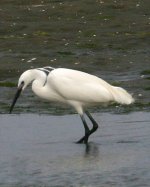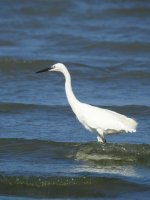The point about the gape is correct.
I'd like to pick up vilbs' point about the plumes on breeding Little Egret.
I know a Great can have a black bill during breeding and it is missing the long plumes from the nape.
vilbs' Little Egret is not in breeding plumage, but post-breeding plumage.
Here in Japan, anyway, the lores on Little Egret become deep pink-red or even purpley-blue at courtship, and the bird has two long plumes on the rear of the head as well as filamentous plumes on the chest and back. I attach two photos of this condition. In the first bird, as well as the red lores, notice that the feet have also turned red. In the second bird, the pupley-blue lores are matched by blueish tibia. (I think these are at the extreme for this colouration here, but I haven't paid enough attention to be sure of this.)
Looking back at photos taken over ten years in my area, I realised that all the birds where the nape plumes are present are showing the deep lore colouration of courtship/breeding plumage. But I also have lots of photos from the summer where the loral colouration has returned to normal, and while the chest and back filaments are still strongly present, the two plumes on the nape have gone. I attach a third photo of a bird in this state which is also the state of vilbs' bird in my opinion.
I don't have any specialist books on herons. Can anyone with more knowledge say if is a known feature of Little Egret that the courtship lore colouration and the nape plumes appear and disappear together for just a short period?
Bonus question: I noticed also that the two strong courtship plumage photos I attach were taken ten weeks apart, one at the end of March (at the shore about 60km away from my home, same latitude), and one in the middle of June (near my house). Is this because the birds breed twice in one year? Or some breed early and some late? Or is it just 'one of those things'?














